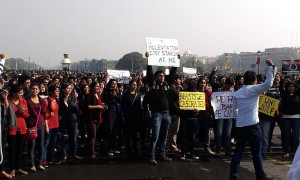Protests Catching Fire in Delhi
As protests have spread across the outskirts of Delhi in North India, the city’s crippled water infrastructure has become the least of the problems. The protests began in neighboring Haryana,

which surrounds Delhi on three sides. In Haryana’s main suburb, Gurgaon, the Jat caste protested the Supreme Court’s 2015 decision to reject its demand to be classified as “Other Backward Class” (OBC). India’s enormous reservation system serves as an affirmative action program that grants preference in college admissions and allocates quotas in government jobs for groups that have been historically marginalized. Classification as an OBC would have allowed the Jats to reap the benefits of such privileges.
However, the Jat’s case for classification as an OBC is weak. The group, though historically agrarian, is one of the more affluent castes in North India. Similar protests by Patels—another relatively affluent caste—in Gujarat also failed to change reservation classifications.
The protests, which began in mid-February, took a violent turn on February 20. During the protests, the Indian Army was deployed to control the riots, and a total of 19 people were killed. Protesters also seized the Grand Trunk Road that leads into Delhi, burned railroad stations, and destroyed the Munak Canal, which provides 55 percent of the water for Delhi.
In response to the destruction of the canal and the subsequent water crisis, the Delhi Government closed all schools on Monday to conserve water and urged citizens to ration water consumption as repairs were made. 760 water tankers were deployed into poorer neighborhoods in Delhi; it is estimated that it will take 15 days for full water service to resume.
The protests in Delhi illuminate two issues: a failing infrastructure and a broken reservation system. The former is a massive problem for Delhi, whose only river— the Yamuna— is incredibly polluted; in turn, Delhi is entirely dependent on neighboring Haryana and Uttar Pradesh for water from the Munak Canal.
However, more troubling is the culture of protest and the “race to the bottom” mentality created by the enormous reservation system. Caste groups seek to be recognized as unfortunate and “backward” to receive preferential treatment rather than advance themselves through economic growth. The system in place has created a perverse incentive where groups would rather be poor than seek to grow. The protests by Jats and Patels also set a dangerous precedent for India, where citizens believe their dissatisfaction with the law can be addressed through violent riots.

As Delhi looks to recover from this blow to its infrastructure, two questions must be answered. On an urban development level: How can Delhi escape the poor infrastructure that holds it back from becoming a global hub? And on a social level: How can the reservation system be modified to encourage sustainable social growth rather than a violent race to the bottom?
